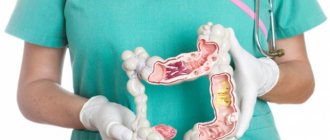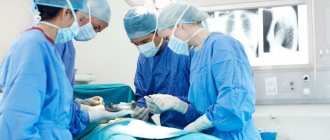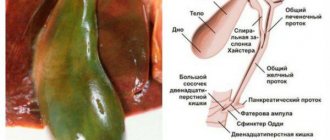Pain in the intestines can indicate various problems in the body. Symptomatic treatment in such cases is prescribed based on the specifics of the sensations themselves (how pronounced they are, where they are localized, how often they appear, etc.) and the presence of other manifestations of the malaise.
As for eliminating the root cause of the disease, if the patient consulted a doctor on time, no problems should arise with this. When should you start sounding the alarm for pain in the rectum? Firstly, medical observation is required in any case in which the patient experiences characteristic discomfort for a day or even more.
Secondly, situations where, in addition to pain, the disease manifests itself with fever or bleeding always imply the need for immediate hospitalization. And finally, thirdly, very special cases are considered to be those when a pregnant woman experiences discomfort.
Haemorrhoids
Hemorrhoids can cause pain in the rectum.
Hemorrhoids are swellings around (and sometimes inside) the anus. The vessels inside such formations are usually greatly dilated.
As a result, the blood forms clots, causing the patient severe discomfort when walking, sitting for long periods of time and, especially, when defecating.
Sometimes the formation of hemorrhoids is accompanied by damage to the skin in the anal area. In such cases, the patient may also have to deal with regular bleeding.
Why do hemorrhoids form? The causes of this disease can be very different. Excessive physical activity, childbirth, or even ordinary constipation can trigger the formation of nodes.
One way or another, pain from hemorrhoids usually appears suddenly, at a stage when the disease has already fully developed. Usually the first manifestations of the disease are accompanied by other characteristic symptoms:
- bleeding after defecation and urination;
- itching, soreness and inflammation of the skin in the anus;
- sensation of a foreign “lump” around the anal sphincter;
- actually, pain in the rectum.
Read: Adhesive disease of the abdominal cavity - how it develops, causes, diagnostic scheme, treatment
The description of the last symptom should be discussed in a little more detail. What causes this pain syndrome? The fact is that blood clots that occur with hemorrhoids often completely block the blood supply to the nodes themselves. The resulting pain usually cannot be relieved with painkillers. And they last for many days in a row. What to do in such a situation?
Treatment of blood clots in hemorrhoids usually involves surgery. During the operation, performed under local anesthesia, the specialist will simply remove excess blood clots from the node. For opponents of such radical therapeutic measures, a more gentle therapy has been developed. Its essence, as a rule, is as follows. The patient is prescribed:
- a special diet (with an emphasis on fiber - to soften stool);
- analgesics and other painkillers;
- laxatives;
- physiotherapy (usually warm baths).
Anal fissures
Anal fissures are damage to the anal canal.
The end of the lower part of the rectum, which is a short tube surrounded by muscles, is called the anal canal.
Any physical damage to the integument of this organ usually causes characteristic pain in the patient. It is this condition that doctors call anal fissure.
The described disease in its symptomatic manifestations almost completely coincides with hemorrhoids. Yes, and both mentioned ailments are treated in the same way. The whole essence of therapy in both cases comes down to making the process of defecation easier for the patient by softening the stool.
How to treat indigestion during pregnancy
Of course, you don’t want to go to the hospital for any reason. Yes, and there is not always time. Therefore, if you need to alleviate your condition on your own, safe medications such as:
Since in the early stages of pregnancy, and in general for the entire nine months, taking medications for the expectant mother is still not recommended, you will have to seek salvation in traditional medicine. If the disorder is caused by overeating or eating poor-quality food, then you can eat a little boiled rice, which is the only one of all cereals that does not cause gas formation. Thick bean soup will also help solve this problem, but it can cause flatulence.
From traditional medicine it is also worth trying:
- infusion of blackberry leaves (3 tablespoons per day);
- pomegranate peel (1 tablespoon per glass of boiling water);
- tea from mint and lemon balm (a spoonful of both herbs in 0.5 liters of water).
Still, it is better to avoid indigestion with the help of a balanced diet, checking the quality of purchased products and normalizing the general psychological background.
The first months of pregnancy are the most exciting for expectant mothers, and only the woman herself, following the advice of experts, can make them as comfortable and safe as possible.
Abscess
An anal abscess is an abscess that forms in the anus. Directly connecting the skin around the sphincter to the infected area, such a formation can bring a lot of discomfort to the patient.
In addition to the characteristic pulsating discomfort in the rectal area, which intensifies with changes in body position, abscesses can manifest themselves as follows:
- irritation of the skin in the anal sphincter area, accompanied by swelling and redness;
- discharge of blood and pus during bowel movements and urination;
- fever (fever, fever, general weakness, etc.).
With successful diagnosis of the inflammatory process at an early stage, the abscess can be successfully treated with antibiotics. However, if such treatment is delayed, they prefer to remove the abscesses surgically.
In especially severe cases, the patient has to undergo not one, but several consecutive operations.
Proctalgia
Crohn's disease causes bloody diarrhea.
This condition is characterized by severe, almost unbearable pain in the lower parts of the rectum, as well as in the anal sphincter area.
Read: Seething in the abdomen after eating: causes and treatment of pathology
Most often, the cause of this reaction is an old injury, as a result of which the pelvic muscles cramp.
Unfortunately, the time of the next attack of proctalgia is almost impossible to predict. Pain syndrome with this disease always occurs suddenly.
How is proctalgia treated? Diagnosis of this disease is carried out by surgeons and psychotherapists. It is these specialists that the patient should visit for consultation first. Treatment (usually consisting of medication) must also be prescribed by a doctor. The patient can only strictly follow his recommendations.
Where is the intestines located during pregnancy?
Your baby is beginning to take on a more rounded shape, and his face and body are now becoming more and more like the face and body of a baby at birth, even though he weighs just over a kilogram and is still very tiny. The bulk of the body weight your baby gains at this stage is aimed at building muscles, bone mass and organ development.
The uterus at 24 weeks of pregnancy should be 5.1 centimeters above the navel, and almost 24 centimeters above the pubic symphysis.
It is believed that this may be due to the hormonal changes your body goes through during pregnancy, where your body is constantly changing and adapting, which in turn causes the blood vessels in your nasal passages to swell and contribute to frequent bleeding.
To solve this problem, you need to use a humidifier and increase the volume of fluid consumed. As a last resort, talk to your doctor about prescribing safe nasal decongestants to use during pregnancy.
Many women are concerned about what exactly they are allowed to eat during pregnancy, while visiting or in a restaurant, especially when it comes to spicy food and overseas dishes.
In principle, these foods are safe to eat during pregnancy, but it is best to stick to the same types of foods that you eat at home, or at least those foods that you have a clear idea of what they contain.
Also try to avoid foods in your diet that you may have enjoyed before, but that now cause heartburn and discomfort.
You must provide your diet with foods that contain enough calcium to provide your body with its daily requirement.
Calcium plays a very important role during pregnancy for you and your baby.
Source
Where is the large intestine located and what does it look like (with photo)
The anatomy of the large intestine differs from the structure of the small intestine. Even the appearance of these two organs makes it possible to unmistakably distinguish them from each other, not to mention their size.
The large intestine is wider, but much shorter, which does not detract at all, but does not in any way exalt its functional significance: the length reaches no more than 2 m, and the width varies in the initial (up to 7 cm) and final (up to 4 cm) sections.
To understand what the large intestine looks like, imagine a corrugated pipe.
Just like it, the large intestine has typical swellings, which are delimited from each other by fairly deep grooves located transversely, as well as by longitudinal bands formed by muscles. There are three such tapes in total.
Their origin is found at the base of the appendix, and they extend all the way to the rectum. It is precisely due to the difference between the length of the ribbons and the intestinal sections between them that the above swellings are formed, which scientists call “haustra”.
The location of the large intestine is such that it covers, figuratively speaking, two “floors” of the body at once: the pelvis and the abdominal cavity.
This organ is notable for the fact that it receives undigested food debris, which is affected by various bacteria living in the intestine.
This is also where some of the water and minerals are absorbed. Ultimately, the lumen of the organ is filled with waste, and feces are formed.
The passage between the small intestine and the thick part is an opening characterized by narrowness and the appearance of a slit and located almost horizontally. In this place there is a special valve in the form of a funnel, with its narrowed end facing the colon. This arrangement prevents content from moving backwards.
Location of internal organs during pregnancy
The process of bearing and giving birth to a child is a normal physiological phenomenon for any woman: since ancient times, nature has provided everything to fulfill this highest destiny of a woman.
And everything in the complex mechanism of the female body is arranged in such a way as to ensure its normal functioning while a little person is growing inside it.
In this regard, changes in all systems and organs of a woman after conceiving a child are inevitable - the body adapts to the new state, and its main task now becomes preserving the fetus and ensuring its normal development.
Therefore, any pregnant woman, from the first months, feels a “restructuring” of organs that before pregnancy worked in a completely different mode. This condition is considered normal if it is not accompanied by any pathological conditions.
First of all, after the baby “settles” in the woman’s body, the pregnant woman’s genitals undergo significant changes. The uterus, in which the fetus gradually grows, increases tenfold as it develops.
So, if before pregnancy the weight of the uterus averaged about 50 grams, by the end of pregnancy this figure can reach 1 thousand grams or more. At the same time, the volume of the uterine cavity also increases: by the time of delivery, its volume can be 520-550 times greater than before fertilization.
The number of muscle fibers in the uterus also increases, the uterine ligaments lengthen, which ensures normal development of the fetus. The ovaries also change in size, increasing in size. In addition, one of them houses the “corpus luteum” - here special hormones are produced that ensure the normal course of pregnancy.
Meanwhile, the vaginal mucosa loosens, the vaginal walls become more elastic - as well as the external genitalia (small and large vulva).
Source
How are internal organs located during pregnancy?
Pregnancy is a unique process, as a result of which the structure of all internal organs completely changes.
The physiological changes that internal organs undergo are natural and provided for by nature.
A woman’s body has everything in place for the successful completion of pregnancy, but the body is subjected to severe stress. Almost every organ works under extreme conditions.
Physiological changes in a woman’s body begin immediately after conception. The body is intensively restructuring, trying to adapt to new conditions and stress as quickly as possible, because the main task of the female body during pregnancy is the normal development of the fetus and maintaining pregnancy.
Changes in the genitals
The vagina becomes loose, elastic, and increases in size. Thanks to this, it will be easier for the baby to pass through the birth canal, and the woman will survive the birth process with less trauma.
Source: https://okishechnike.com/info/gde-nahoditsja-kishechnik-pri-beremennosti/
Crohn's disease
Many inflammatory bowel diseases manifest themselves in the form of specific pain. Crohn's disease is just one of them, the most common. Other characteristic symptoms of this disease are:
- convulsions;
- bloody diarrhea;
- sudden weight loss.
Diagnosis (and, consequently, prescribing treatment) for this disease should be carried out exclusively by specialists. As a rule, doctors prescribe purely symptomatic therapy to patients with Crohn's disease. This usually involves taking special medications.
Oncology
Rectal cancer manifests itself in the same way as hemorrhoids.
Cancer of the rectum or anus usually presents in the same way as hemorrhoids.
Correct diagnosis of such diseases is usually helped by characteristic symptoms such as anal bleeding and bowel movements. Moreover, over time, all the mentioned signs of the disease begin to manifest themselves more and more.
To confirm or refute suspicion of oncology, the patient should consult a surgeon specializing in such diseases. After a physical examination, the doctor will likely refer the patient for additional tests (stool test, biopsy, etc.).
As for treatment, today radiation and chemotherapy help fight cancer quite effectively.
However, the need for banal surgical intervention cannot be ruled out.
Prevention
To prevent rumbling in the stomach, it is recommended to adhere to the basic principles of a healthy diet, avoid the use of spicy seasonings and simple carbohydrates. fried, heavy foods, chips, crackers, carbonated water. Food should be varied, nutritious, without dyes, preservatives and harmful chemicals. You need to chew food thoroughly, refrain from emotional conversations and watching gadgets or TV while eating.
Doctors also advise following these recommendations:
- Eliminate from your diet foods that are difficult to digest: fresh baked goods, cabbage, legumes, dairy products.
- Avoid drinking highly carbonated and alcoholic drinks.
- Drink tea based on the fruits of anise, fennel and mint leaves, chamomile, ginger after meals.
- Use enzyme and choleretic medications as prescribed by your doctor.
- Take your last meal 3 hours before bedtime.
- Enrich your diet with whole grain cereals and flour.
- Give preference to moderate physical activity: walk at least 10,000 steps in the fresh air every day, do yoga for pregnant women, and breathing practices.
Doctors do not recommend immediately going to bed to rest after a hearty breakfast or lunch; it is better to move around a little. At the first symptoms of a disorder, it is recommended to stop self-medicating and consult a doctor. The earlier therapy begins, the better the prognosis.
Other diseases that cause rectal pain
Prostatitis can also cause pain in the rectum.
Pain in the intestines is not always a sign of problems with this organ.
Diseases affecting other systems of the body (usually the genitourinary system) often manifest themselves in this way:
- rising pain syndrome (characterized by constant or periodic pressure around the anus, more common in women);
- infections caused by a fungus or STD (most often HIV, gonorrhea, syphilis, chlamydia or herpes);
- arthritis and bone tumors (pain in the tailbone can spread to the entire pelvic area, which can mistakenly suggest problems with the intestines);
- prostatitis (as well as other urinary tract problems);
- psoriasis (like some other skin conditions, such as warts, inflammation can affect the area near the anus and cause symptoms characteristic of rectal problems).
Read: How to restore the intestinal mucosa
This video will tell you what may cause pain in the rectum:
How is the intestines located during pregnancy?
Pain of a paroxysmal nature in the lower abdomen or in the iliac region may indicate problems with the intestines. In pregnant women, such problems occur in all trimesters for various reasons. You should not let the process take its course - a consultation with a doctor will help restore good health, and proper therapy will be the key to the full development and health of the unborn baby.
Intestines and its functions
The intestines perform several important functions in the body. It is located in the middle and lower abdomen, its structure is very complex. This part of the digestive system ensures the absorption of nutrients and the absorption of vitamins. Along the way, they produce the necessary digestive enzymes. The next important stage is the elimination of waste in the form of feces.
The intestines contain colonies of microorganisms that provide the appropriate stage of food digestion, including lactic acid bacteria. These bacteria supply the body with lactose, B vitamins, and also produce ethyl alcohol. With their help, fats, carbohydrates and proteins are broken down.
Photo of human intestines
It is necessary to maintain a normal balance of intestinal microflora, since the baby in the womb does not have its own bacteria. He receives them from his mother during childbirth and breastfeeding. During pregnancy, many women suffer from dysbiosis, which also affects the health of the unborn baby.
Location of organs during pregnancy
Internal organs experience increased stress during pregnancy. Hormonal levels are actively changing, and this is reflected in the functioning of all body systems. The uterus enlarges: already in the 4th week it reaches the size of a chicken egg, and subsequently extends beyond the pelvic bones. The location of the organs shifts, which sometimes causes stomach pain.
As the fetus develops, a woman's anatomy changes more and more. The need for oxygen increases, the lungs process a larger volume of air. Breathing quickens, but the hormone progesterone regulates the functioning of the bronchi, and this allows you to avoid shortness of breath at least in the early stages. In the second and third trimesters, the diaphragm shifts, causing breathing to become more frequent and shallow.
The fetus takes up more and more space in the abdominal cavity, and the gallbladder, bladder, and kidneys experience increasing pressure. The liver moves to the side and higher, the normal flow of bile becomes difficult, this leads to the appearance of colic. In the tissues of the uterus, the number of vessels supplying the fetus with blood increases, the load on the heart muscle increases, and its volume increases.
The stomach and intestines also move from their usual places. In the first trimester, they begin to rise upward, a side effect of which is that gastric juice enters the esophagus. Before birth, the intestines move apart and the uterus descends. Gases accumulate in the intestines, a feeling of fullness, pain, and defecation may occur.
How does pregnancy affect the intestines?
During pregnancy, due to changes in hormonal levels and displacement of internal organs, intestinal function becomes more difficult. The amount of microflora decreases, women suffer from gas accumulations and spasmodic pain. Fermentation often occurs in the intestines, increasing unpleasant symptoms.
Diet while expecting a baby does not mean reducing calories, but including in the menu foods that contain all the nutrients necessary for the mother and fetus. A balanced diet allows you to normalize the balance of bifidobacteria and lactobacilli in the intestines and improve digestion.
In early pregnancy, as the fertilized egg moves to the site where it attaches to the wall of the uterus, women experience abdominal pain.
In the future, unpleasant sensations are caused by the growth of the fetus, due to which the uterus puts pressure on the intestines. In this case, there is a stabbing sensation in the lower abdomen, and sometimes even slight bleeding appears.
If the bleeding does not stop, seek medical help. Deterioration of the condition is indicated by spasms, a feeling of pressure, and prolonged constipation.
Pain in the intestines: what is the cause?
To successfully deal with intestinal pain, it is necessary to determine its cause.
In addition to natural compression due to a developing pregnancy, a woman may suffer from a number of diseases, both existing before conception and those that developed after it.
Peristalsis disturbances can be associated with both physiological causes and infection. For example, the hormone progesterone, the amount of which is significantly increased at this time, reduces the level of peristalsis.
Physiological changes in the body of a pregnant woman
In order for the uterus to grow and provide space for the development of the fetus, muscle tone in the body is reduced. This is necessary for the child, but bad for the intestines, which become “lazy”. Digestion worsens, constipation occurs more often, gas is tormented, and intestines hurt.
Towards the end of pregnancy, the uterus is already quite large, it puts pressure on the organs that are located nearby. Their blood supply is disrupted and their functioning is complicated. Women suffer from stomach rumbling, colic and bloating.
Expectant mothers are forced to change their diet and eat unusual foods, which also causes indigestion. At the same time, the functioning of all digestive organs, in particular the pancreas, liver, and spleen, deteriorates.
Infectious lesions
In cases where pain in the intestines is accompanied by diarrhea, fever, nausea or vomiting, infection is likely. The disease can be caused by viruses or bacteria and is in no way related to pregnancy. This may look like:
- dysentery;
- salmonellosis;
- rotavirus infection;
- enterovirus infection;
- “conquered diseases” - cholera, typhoid fever - brought from foreign trips.
Infectious diseases during pregnancy are very dangerous and threaten to terminate the pregnancy.
In this case, it is necessary to urgently call a doctor and take auxiliary measures - often drink water in small portions, take rehydration medications, and cleanse the digestive system using sorbents or activated carbon. The doctor will prescribe antimicrobial drugs and recommend restorative therapy and diet.
Neoplasms of various etiologies
Pregnancy forces all the body’s hidden reserves to come into play, but at the same time latent diseases are also activated.
Due to a decrease in immunity and hormonal changes, pathologies may appear that the woman did not know about before. One of the most dangerous is the appearance and activation of neoplasms.
Polyps may appear in the intestines, which, as they increase in size, cause regular pain.
Unfortunately, surgical treatment of such diseases during pregnancy is undesirable. Surgical intervention in the pelvic organs increases the tone of the uterus and can provoke a miscarriage. Treatment is carried out immediately in cases where the threat to a woman’s life outweighs the possible risks. In the presence of tumors, only maintenance therapy is indicated.
Colitis or enterocolitis
Pain in the abdominal area can be caused directly by diseases of the gastrointestinal tract (see also: can the stomach hurt during pregnancy?). With the increased load placed on the intestines during pregnancy, the manifestations of colitis, enterocolitis or Crohn's disease intensify. These conditions are distinguished by:
- severe pain in the iliac region;
- aching or stabbing pain near the navel;
- increased gas formation, flatulence;
- the appearance of blood, mucus or even pus in the stool;
- frequent constipation or diarrhea.
Source: https://luxeth.ru/kak-raspolozhen-kishechnik-vo-vremja-beremennosti/
If the patient is pregnant
Pregnancy is a special state of the body in which any, even the most insignificant “sore” can lead to very serious consequences for the woman and her unborn child.
Therefore, if a lady is really worried about the health of her unborn baby, she should not ignore such an alarming symptom as pain in the rectum. What is the specificity of this condition during pregnancy?
Unfortunately, while a woman is pregnant, the internal pressure in her abdominal cavity increases greatly. And, as the child develops in utero, this figure only grows. Due to constant pressure on the rectum, a woman may experience characteristic pain.
However, this is far from the worst thing. An enlarged uterus is fraught for the expectant mother with an exacerbation of all her existing chronic intestinal diseases (for example, colitis or proctitis), as well as the appearance of new ones: hemorrhoids and regular constipation caused by impaired peristalsis.
To prevent such critical consequences, a pregnant woman should monitor her condition very carefully. At the first manifestation of unpleasant symptoms (pain or discomfort in the intestines), she should immediately contact her doctor.
Location of internal organs during pregnancy
Nature is wise and has thought out everything for bearing and giving birth to a child.
The female body, one might say, is perfect; everything in it is provided for the formation and further development of a small person. Naturally, the body needs some restructuring after conceiving a child and it begins to gradually adapt to the new state. A woman begins to feel the restructuring of her body literally from the very first months. If a woman does not exhibit any pathological abnormalities, then such a restructuring is considered normal. What organs undergo changes in the female body first?
These are the genitals of a pregnant woman . It is in the uterus that the fetus grows, which leads to a significant increase in its size, and from the pear-shaped one it acquires an ovoid shape. By the time of delivery, the volume of the uterine cavity, just imagine, can be 520-550 times larger compared to the period before fertilization.
There is also an increase in muscle fibers in the uterus, as a result of which the uterine ligaments lengthen, which ensures the normal development of the fetus. The ovaries also undergo changes; they increase in size. In one of them the “corpus luteum” is concentrated, where special hormones are produced, which ensures the normal course of pregnancy.
The vaginal mucosa loosens, and its walls become more elastic. Mucus accumulates in the cervix. In the future, these changes will help in the easy passage of the baby through the birth canal. It turns out that all changes in a woman’s physiology are very important.
Changes in the genital organs also lead to restructuring of the digestive and urinary . Most women are familiar with changes in taste preferences, their appetite increases sharply, and a craving for sour or salty foods appears.
Some women generally develop rather strange taste preferences; they start to like soap, chalk, and clay.
Such dramatic transformations are explained by changes in the tone of the vagus nerve, which regulates the functioning of most internal organs.
Regarding the digestive organs , the growing uterus affects the condition of the intestines, which shift under the pressure of the uterus upwards and to the sides, and intestinal tone decreases. This leads to frequent constipation in pregnant women.
The stomach responds to compression of the growing uterus with heartburn. Constant consumption of mineral water should prevent this phenomenon; avoiding late dinner will also be useful.
The enlarging uterus also puts pressure on the bladder, which leads to increased urination.
the mammary glands lead to future lactation . This happens against the background of general hormonal changes. As a result, hormones such as prolactin, estrogen, and progesterone are produced. Towards the end of pregnancy, the mammary gland begins to produce colostrum.
The liver is another important organ that puts a lot of stress on during pregnancy.
Thanks to this natural filter, the mother’s body is cleansed of decay products, as well as toxins that can cause harm to the baby are neutralized.
The liver, like other organs, changes its location, takes a lateral position, being pushed upward by the uterus. In this case, there is a possibility of obstruction of the outflow of bile, which leads to hepatic colic. The kidneys also function with double load.
An increased load is also observed in the cardiovascular system , because a growing fetus needs a sufficient amount of oxygen and nutrients. The volume of circulating blood increases by 1.5 liters, and a new placental circulation occurs in the body. As a result, the mass of the heart muscles increases and their contraction becomes more frequent. An increased heart rate during pregnancy is caused by this factor; the rate of heart beats in the second trimester of pregnancy reaches 75-90 per minute. During this period, the venous system . As a complication - varicose veins. This happens not only due to the constantly increasing weight load on the lower limbs. A large role in this is played by the deformation of the inferior vena cava, which is responsible for collecting blood from the uterus, pelvic organs and, of course, the legs. This vessel is anatomically located to the right of the spine and is compressed when a woman sleeps on her back. Doctors do not recommend pregnant women sleep in a supine position; they also advise using pads under their feet, which promotes freer blood flow. The increase in erythrocyte mass lags somewhat behind the general increase in blood volume, while reducing blood viscosity. Prescribing iron supplements will improve the blood composition of a pregnant woman.
in blood pressure are also observed. It may be reduced in the first half of pregnancy, and slightly increased in the second half. A pregnant woman's blood pressure should be monitored, as any fluctuations may indicate the presence of certain pregnancy complications.
Changes in the location of internal organs also affect the functioning of the respiratory organs . The lungs are forced to work harder due to the fact that the enlargement of the uterus limits the movement of the diaphragm, and the child is in dire need of oxygen. At the same time, the breathing frequency increases, becoming deeper.
The volume of the lungs increases slightly, the tissue becomes more juicy, and the bronchial mucosa swells. Changes in the respiratory system and, as a consequence, difficulties in gas exchange in the last months of pregnancy lead to an increased risk of inflammatory diseases of the respiratory tract. There are techniques offered by doctors, the essence of which boils down to saturating the body with oxygen.
The changes also affect the skeletal system of the pregnant woman. There is an increase in the concentration of progesterone and relaxin in the blood, and as a reverse effect, calcium is washed out. This microelement is used for the formation of fetal bone tissue. The pelvic bones and their joints become more elastic. The most dangerous is the leaching of calcium from the spine and foot bones.
The general course of pregnancy is also greatly influenced by the endocrine glands , which also undergo a number of changes. Especially regarding the pituitary gland, which not only increases in size, but also changes morphologically. There is an increase in the number of cells producing the hormone prolactin, which is responsible for increasing milk production. In addition, the neurohormones vasopressin and oxytocin accumulate in the posterior pituitary gland.
Changes in a woman's body
Let us note that all the changes that occur in a woman’s body are normal physiological phenomena. Restructuring of organs is a temporary phenomenon, usually disappearing after the birth of the baby. During this important period, frequent walks, hygiene, proper balanced nutrition and regular good sleep are necessary.
Source: https://mamapedia.com.ua/beremennost/vse-o-beremennosti/raspolozhenie-vnutrennih-organov-pri-beremennosti.html
Where can you go if you have pain in the rectum?
If you have pain in the rectum, you should consult a proctologist.
With prolonged pain, rectal bleeding and deterioration in general health, seeking medical help becomes a necessity for any patient. But which specialist should you contact for problems with the rectum?
If any pain syndrome occurs, the best thing a patient can do is to contact a physician who is constantly monitoring him.
Such a specialist will quickly conduct a superficial diagnosis of the disease and, if necessary, send the patient for additional studies. Including – to doctors of other specializations:
- gastroenterologist;
- urologist;
- oncologist;
- surgeon;
- proctologist;
- infectious disease specialist;
- gynecologist (for pregnant women).
Read along with this article:
- A lump near the anus: is it hemorrhoids?
- Is severe pain in the lower abdomen a reason to call an ambulance?
- Pain in the rectum and lower abdomen: what is evidenced by...
- Why does pain occur in the anus?
- There is blood coming from the anus: why does pathology occur...
- Papillitis is a disease that you shouldn’t remain silent about...
- What is rectal prolapse? Symptoms and treatment
- What causes anal bleeding
- Ointment for the treatment of external hemorrhoids and what are hemorrhoids,...
Gastrointestinal tract disorder: causes and first aid
It is necessary to remember the reasons that lead to digestive problems:
- poisoning from stale or poor-quality food;
- binge eating;
- the emergence of an addiction to certain foods that were either not consumed before pregnancy or in smaller quantities;
- purchasing products from cafes or fast food outlets;
- dysbacteriosis;
- stress.
One of the most delicate problems that await an expectant mother is a disorder accompanied by diarrhea. Toxicosis is often perceived by pregnant women as an inevitable and obligatory phenomenon, and intestinal upset during early pregnancy leads to panic and confusion.
You should know that diarrhea is not a disease, but only a signal of an irritant from the external environment. In the first three months, loose stools can also be a side effect of toxicosis, when a woman begins to eat foods that were previously unusual for her in order to eliminate nausea. Stress can also trigger diarrhea, because expectant mothers are most susceptible to emotional swings.
As for the threat to the fetus, there are several risk factors for this phenomenon.
- the possibility of miscarriage in the first trimester due to increased intestinal motility, which can lead to uterine contractions;
- sometimes diarrhea is accompanied by fever, which also adversely affects the unborn child;
- poisoning caused by toxins is one of the most dangerous;
- diarrhea accompanied by vomiting leads to dehydration and loss of those substances that the baby needs so much.











